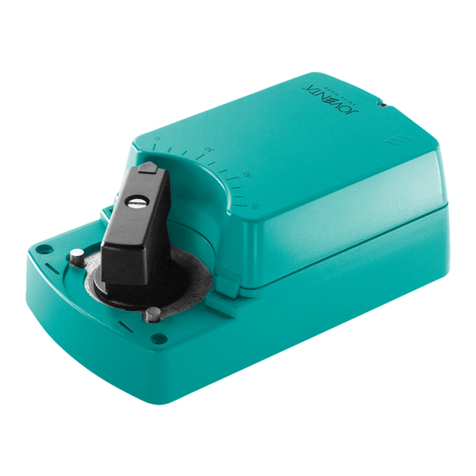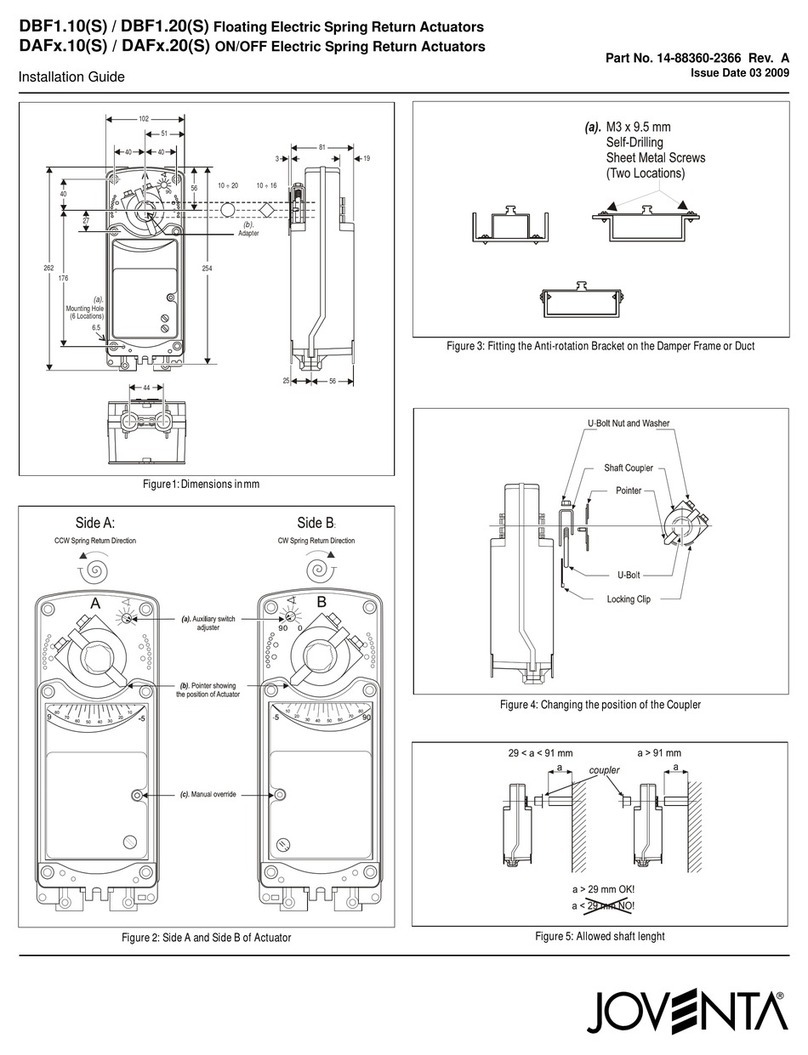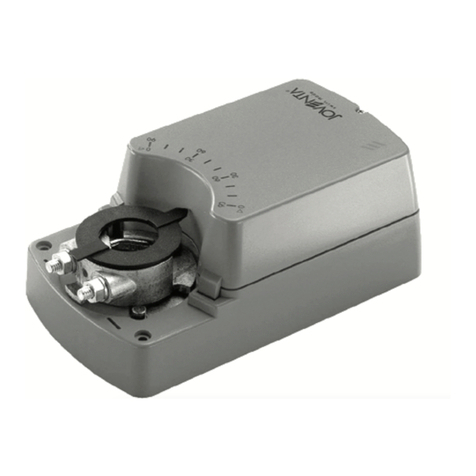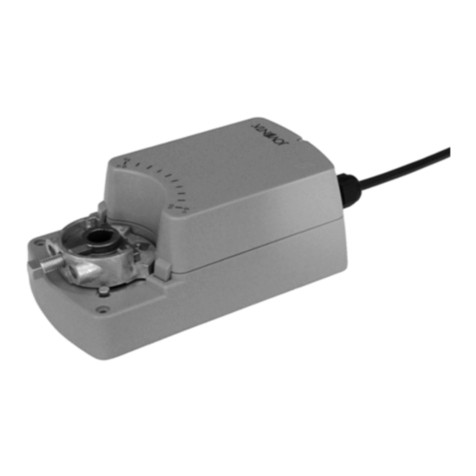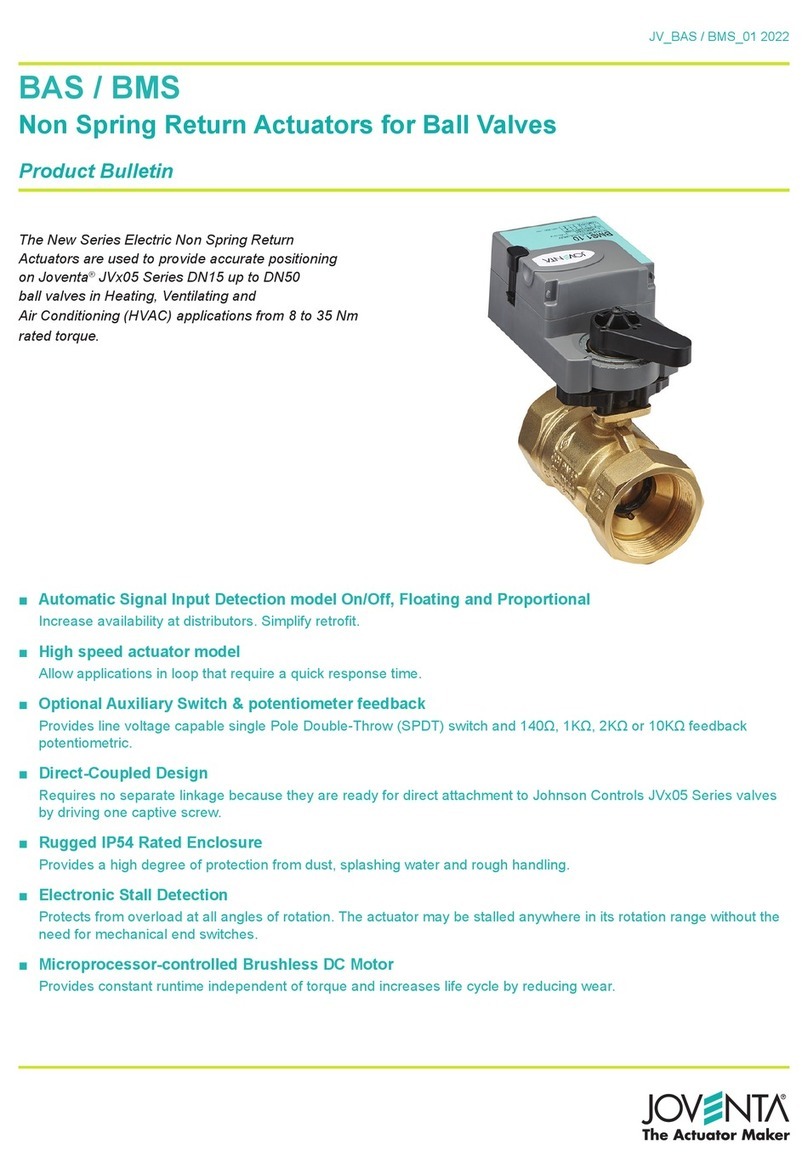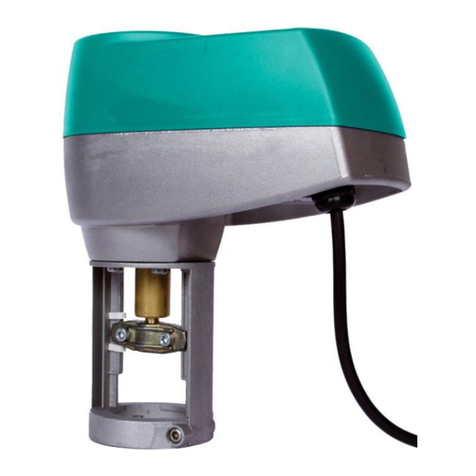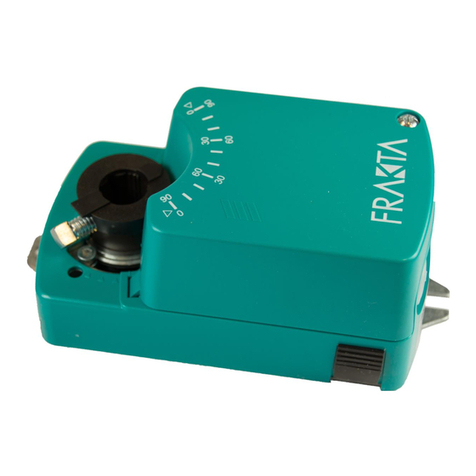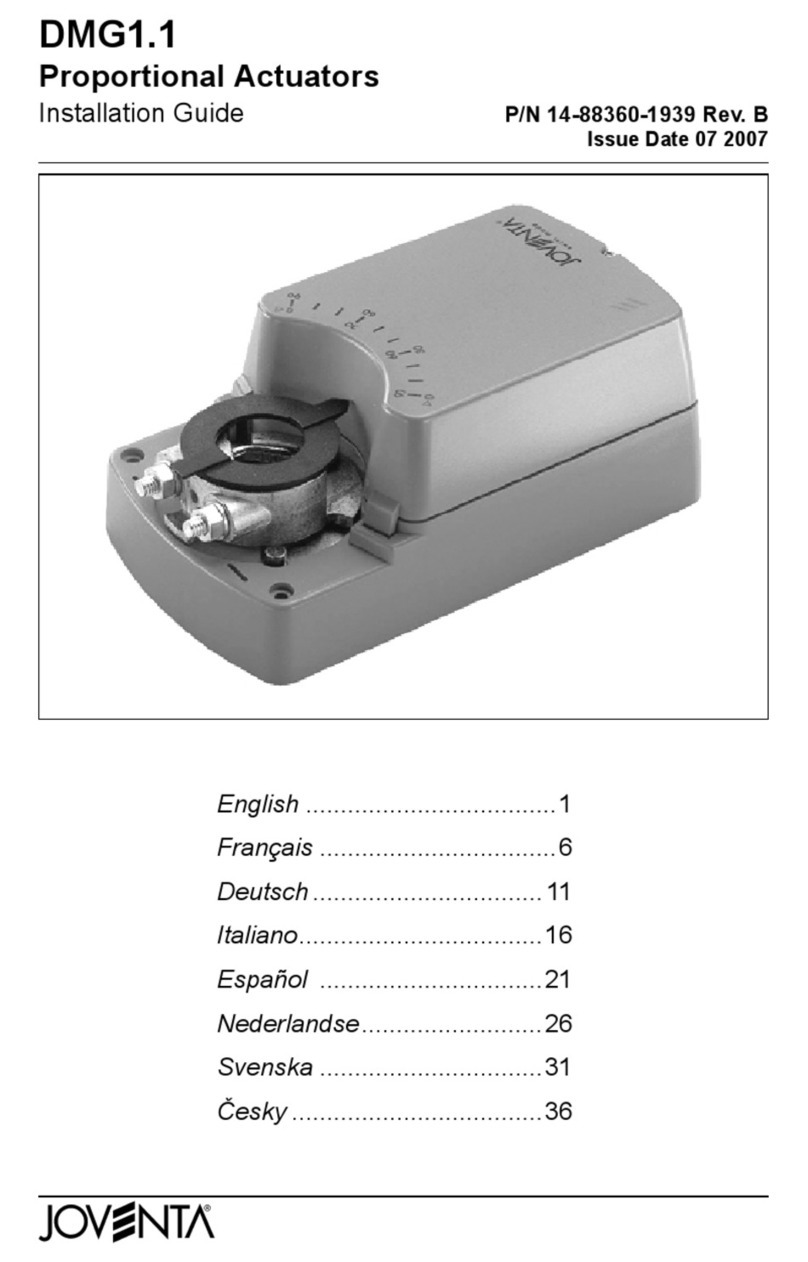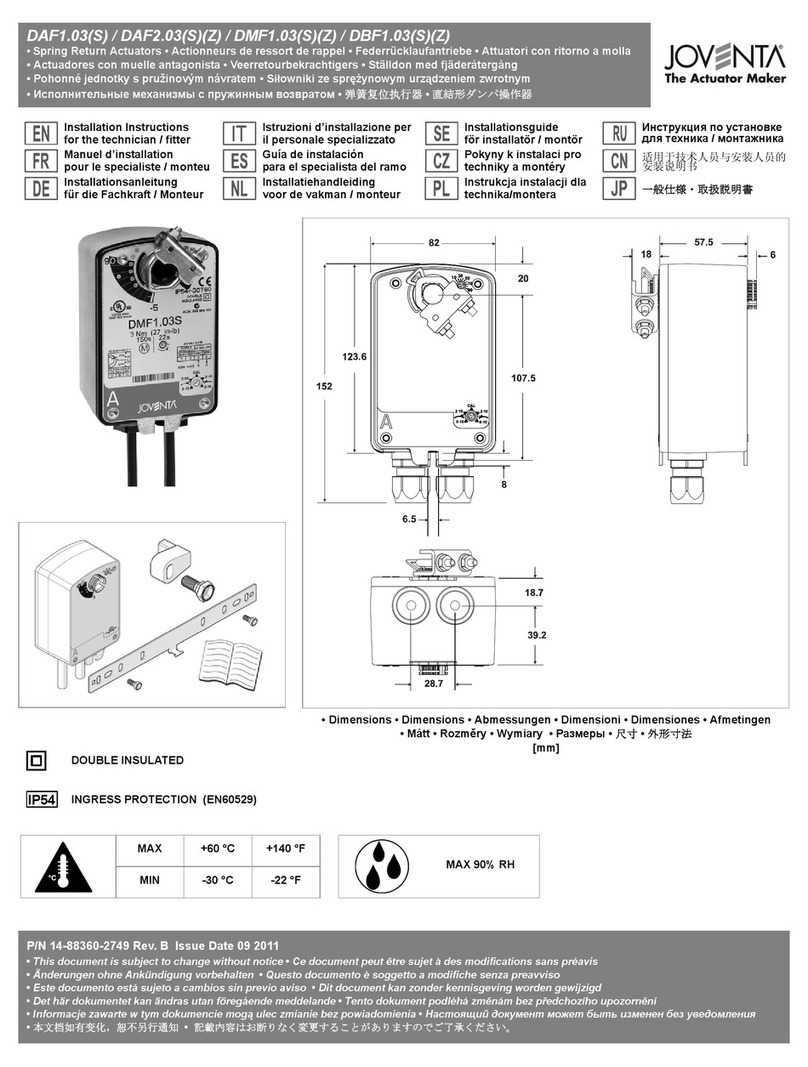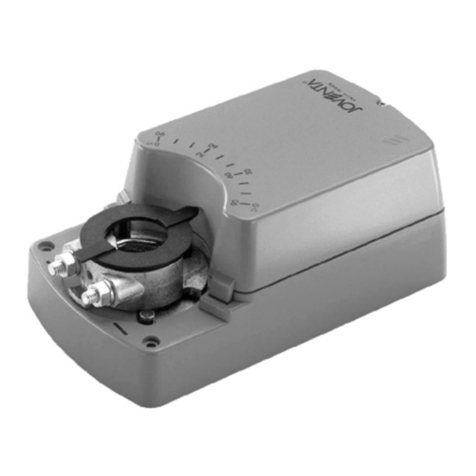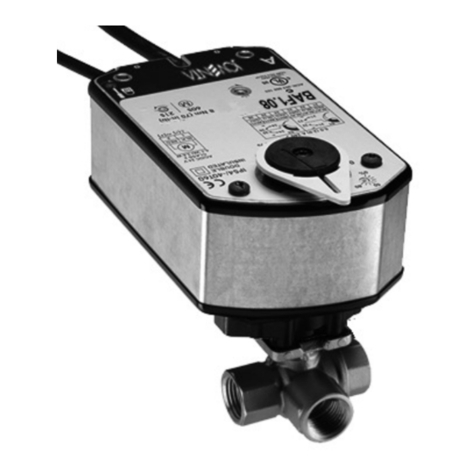
Italiano IS_DMS2.5 / DM2.5 / DML2.5_14-88360-1947_Rev. C_01 2010
Questo documento è soggetto a modifiche senza preavviso 7
LEGGERE ATTENTAMENTE QUESTE ISTRUZIONI E LE
AVVERTENZE PRIMA DELL'INSTALLAZIONE E
CONSERVARLE PER USO FUTURO
Funzioni generali
Gli attuatori sono progettati per il funzionamento delle
serrande nei sistemi HVAC (Heating, Ventilation and Air
Conditioning). L'adattatore universale consente il montaggio
diretto degli attuatori sul perno della serranda dove vengono
fissati con il dispositivo di bloccaggio fornito.
Figura 1: Dimensioni in mm
(a). Vite coperchio
Modo di funzionamento
Figura 2: Attuatore aperto
(a). Impostazione predefinita interruttore ausiliario:
10° (CW)
(b). Impostazione predefinita interruttore ausiliario:
80° (CW)
(c). Connettore motore
(d). Microinterruttore
(e). Pulsante manuale
(f). Adattatore per:
Perni rotondi: Ø 10...20 mm
Perni quadrati: 10...16 mm
(g). 1- Limitazione dell'angolo di rotazione
2- Sbloccaggio dell'adattatore
(h). Segnali di controllo di regolazione
Gli attuatori sono controllati per mezzo di un segnale 0(4)...20
mA. Il motore si arresta quando viene raggiunto il fine corsa
della serranda o il fine corsa dell'attuatore. Per il
funzionamento manuale della serranda, il sistema di
ingranaggi viene disinnestato attraverso l'utilizzo del pulsante
di ripristino automatico (vedere la figura 2 e.).
Installazione e regolazione
Figura 3: Istruzioni per il montaggio
Installazione
Collegare l'attuatore al perno della serranda mediante
l'adattatore e fissare il dispositivo di bloccaggio con le viti
fornite.
Limitazione dell'angolo di rotazione
È possibile limitare meccanicamente l'angolo di rotazione/
intervallo di funzionamento (figura 2 g1.) su un valore inferiore
a 90° riposizionando l'adattatore in passi di 5°, in base alle
esigenze. Per sbloccare l'adattatore, premere semplicemente
i relativi fermagli nel lato inferiore dell'attuatore (figura 2 g2.).
Selezione della direzione di rotazione
• Per invertire la direzione di rotazione (CW/CCW), allentare
la vite (vedere la figura 1 a.) e rimuovere la copertura.
• È possibile invertire la direzione di rotazione con
l'interruttore (vedere la figura 2 d.).
• Impostazione predefinita: rotazione oraria (CW).
Cablaggio
Schemi di cablaggio
Figura 4: Controllo proporzionale
Figura 5: Dati del segnale
(a). Microinterruttore
Figura 6: Connessione parallela max. 5 attuatori
Figura 7: Interruttori ausiliari
(a). Impostazione predefinita interruttore ausiliario:
10° CW
(b). Impostazione predefinita interruttore ausiliario:
80° CW
(c). Attuatore nella posizione 0°
Connessioni elettriche tramite trasformatore di
sicurezza
• Per eseguire le connessioni elettriche, allentare la vite
(fig. 1 a.) e rimuovere la copertura.
•Schema cablaggio attuatore: in base alla connessione
terminale (fig. 4).
•Connessione parallela: in base alla connessione terminale
(fig. 6).
•Interruttori ausiliari: in base alla connessione terminale
(fig. 7).
•Potenziometro di retroazione: non possibile.
•Il lavoro di installazione elettrica deve essere eseguito
da un tecnico specializzato.
• Connessioni errate possono danneggiare l'apparecchiatura.
Controllare le connessioni prima di dare tensione
all'alimentatore.
• Durante l'operazione di installazione degli attuatori rispettare
sempre le normative locali di prevenzione degli infortuni.
• L'attuatore si sposta leggermente durante il funzionamento,
pertanto è importante utilizzare cavetti flessibili per le
connessioni elettriche.
Regolazione degli interruttori ausiliari
(vedere le figure 2 a. - b.)
Esempio:
regolazione della posizione di commutazione a. su 30° e b. su 70°.
30°: spingere il pulsante manuale (figura 2 e.) e ruotare
l'adattatore (figura 2 f.) nella posizione 30°. Allentare
leggermente la vite con testa a croce nell'eccentrico a. in
modo da poter spostare l'ingranaggio manualmente. Ruotare
l'eccentrico a. in senso antiorario fino a quando l'interruttore
di accensione è visibile. Serrare nuovamente la vite con testa
a croce nell'eccentrico a..
AVVERTENZA: quando si calcola la coppia
richiesta per il funzionamento delle serrande, è
necessario considerare tutti i dati forniti dal
produttore della serranda.
AVVERTENZA:
• Eseguire i collegamenti elettrici degli attuatori
rispettando le normative legali relative.
•Per evitare lesioni personali o danni
all'apparecchiatura o altre proprietà, isolare
sempre l'alimentatore prima di iniziare
qualsiasi operazione sul cablaggio elettrico.
• Per evitare danni a proprietà, è importante
utilizzare l'apparecchiatura solo per lo scopo
designato.
AVVERTENZA: i circuiti integrati all'interno
dell'attuatore sono sensibili all'elettricità
statica. Adottare le precauzioni del caso.
